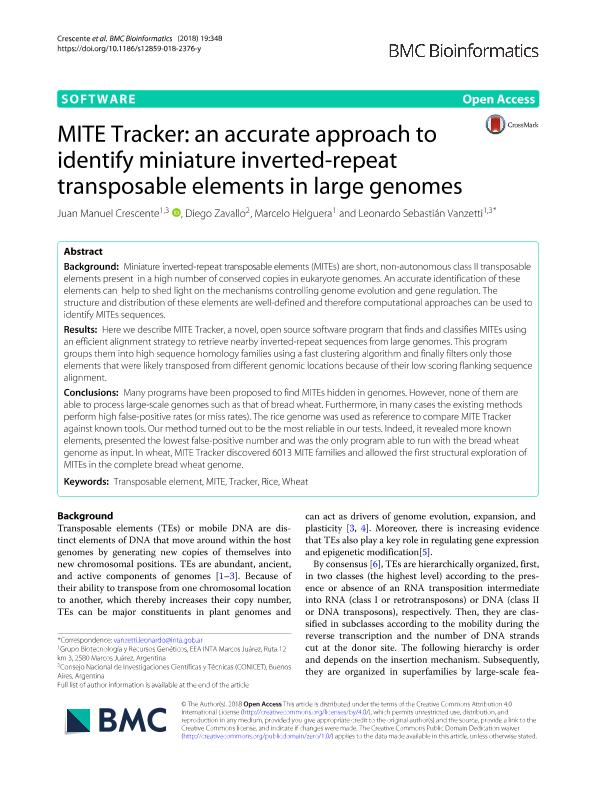Mostrar el registro sencillo del ítem
dc.contributor.author
Crescente, Juan Manuel

dc.contributor.author
Zavallo, Diego

dc.contributor.author
Helguera, Marcelo

dc.contributor.author
Vanzetti, Leonardo Sebastián

dc.date.available
2020-02-21T21:21:09Z
dc.date.issued
2018-10
dc.identifier.citation
Crescente, Juan Manuel; Zavallo, Diego; Helguera, Marcelo; Vanzetti, Leonardo Sebastián; MITE Tracker: An accurate approach to identify miniature inverted-repeat transposable elements in large genomes; BioMed Central; BMC Bioinformatics; 19; 1; 10-2018; 1-10
dc.identifier.issn
1471-2105
dc.identifier.uri
http://hdl.handle.net/11336/98361
dc.description.abstract
Background: Miniature inverted-repeat transposable elements (MITEs) are short, non-autonomous class II transposable elements present in a high number of conserved copies in eukaryote genomes. An accurate identification of these elements can help to shed light on the mechanisms controlling genome evolution and gene regulation. The structure and distribution of these elements are well-defined and therefore computational approaches can be used to identify MITEs sequences. Results: Here we describe MITE Tracker, a novel, open source software program that finds and classifies MITEs using an efficient alignment strategy to retrieve nearby inverted-repeat sequences from large genomes. This program groups them into high sequence homology families using a fast clustering algorithm and finally filters only those elements that were likely transposed from different genomic locations because of their low scoring flanking sequence alignment. Conclusions: Many programs have been proposed to find MITEs hidden in genomes. However, none of them are able to process large-scale genomes such as that of bread wheat. Furthermore, in many cases the existing methods perform high false-positive rates (or miss rates). The rice genome was used as reference to compare MITE Tracker against known tools. Our method turned out to be the most reliable in our tests. Indeed, it revealed more known elements, presented the lowest false-positive number and was the only program able to run with the bread wheat genome as input. In wheat, MITE Tracker discovered 6013 MITE families and allowed the first structural exploration of MITEs in the complete bread wheat genome.
dc.format
application/pdf
dc.language.iso
eng
dc.publisher
BioMed Central

dc.rights
info:eu-repo/semantics/openAccess
dc.rights.uri
https://creativecommons.org/licenses/by-nc-sa/2.5/ar/
dc.subject
MITE
dc.subject
RICE
dc.subject
TRACKER
dc.subject
TRANSPOSABLE ELEMENT
dc.subject
WHEAT
dc.subject.classification
Otras Ciencias Biológicas

dc.subject.classification
Ciencias Biológicas

dc.subject.classification
CIENCIAS NATURALES Y EXACTAS

dc.title
MITE Tracker: An accurate approach to identify miniature inverted-repeat transposable elements in large genomes
dc.type
info:eu-repo/semantics/article
dc.type
info:ar-repo/semantics/artículo
dc.type
info:eu-repo/semantics/publishedVersion
dc.date.updated
2020-02-18T16:03:34Z
dc.journal.volume
19
dc.journal.number
1
dc.journal.pagination
1-10
dc.journal.pais
Reino Unido

dc.journal.ciudad
Londres
dc.description.fil
Fil: Crescente, Juan Manuel. Instituto Nacional de Tecnología Agropecuaria. Centro de Investigaciones Agropecuarias. Instituto de Fisiología y Recursos Genéticos Vegetales; Argentina. Consejo Nacional de Investigaciones Científicas y Técnicas; Argentina
dc.description.fil
Fil: Zavallo, Diego. Instituto Nacional de Tecnología Agropecuaria. Centro Nacional de Investigaciones Agropecuarias; Argentina. Consejo Nacional de Investigaciones Científicas y Técnicas; Argentina
dc.description.fil
Fil: Helguera, Marcelo. Instituto Nacional de Tecnología Agropecuaria. Centro de Investigaciones Agropecuarias. Instituto de Fisiología y Recursos Genéticos Vegetales; Argentina
dc.description.fil
Fil: Vanzetti, Leonardo Sebastián. Consejo Nacional de Investigaciones Científicas y Técnicas; Argentina. Instituto Nacional de Tecnología Agropecuaria. Centro de Investigaciones Agropecuarias. Instituto de Fisiología y Recursos Genéticos Vegetales; Argentina
dc.journal.title
BMC Bioinformatics

dc.relation.alternativeid
info:eu-repo/semantics/altIdentifier/url/https://bmcbioinformatics.biomedcentral.com/articles/10.1186/s12859-018-2376-y
dc.relation.alternativeid
info:eu-repo/semantics/altIdentifier/doi/https://doi.org/10.1186/s12859-018-2376-y
Archivos asociados
